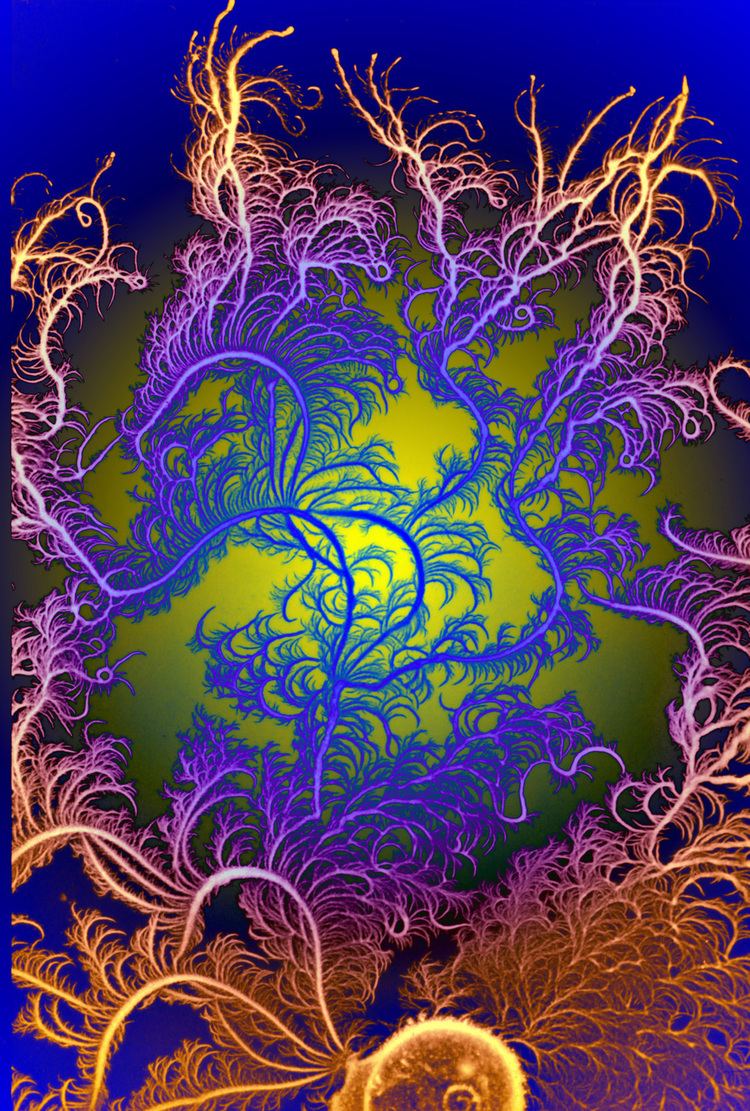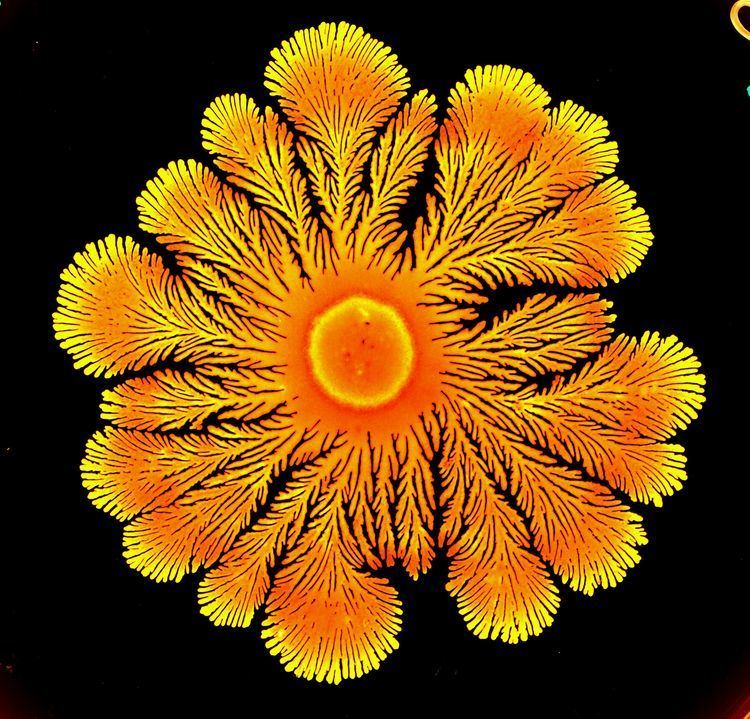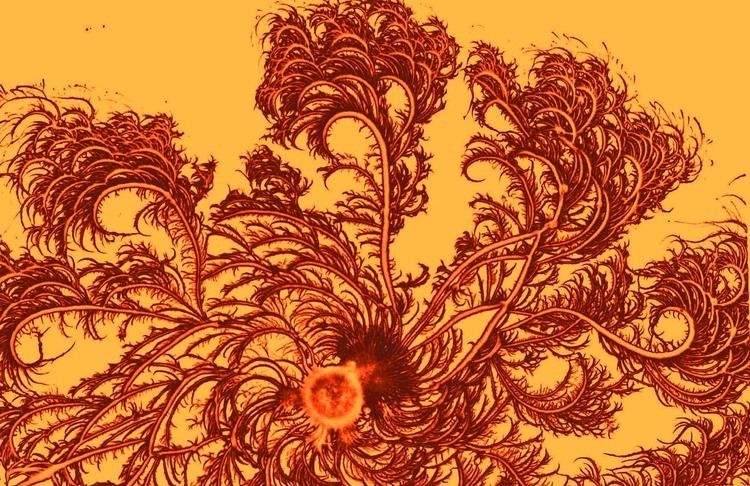Name Eshel Ben-Jacob | ||
 | ||
Born April 13, 1952Haifa, Israel ( 1952-04-13 ) Institutions University of Michigan (1984-1989)Tel Aviv University (1986-2015)Fellow CTBP, UCSD (2004-2013)Fellow CTBP, Rice University (2013-2015) Alma mater Tel Aviv University (B. Sc., M.Sc. and PhD) Known for Pattern formation and self-organization (the snowflake problem), coulomb blockade and single electron based transistor, collective swarming (swarm intelligence), social behaviors of bacteria, systems neuroscience: creation of the first hybrid neuro-memory-chip, "Let the complex be simple"—simplifying biocomplexity Notable awards Landau Research Prize (1986), The Siegle Research Prize of the Israel Academy of Sciences and Humanities (1996), SciAm 50 (2007), Weizmann Prize in Exact Sciences (2013), International member of the American Philosophical Society (2014) Residence Israel, United States of America | ||
2013 weizmann prize eshel ben jacob
Eshel Ben-Jacob (full name Eshel Refael Ben-Jacob Breslav; Hebrew: אשל רפאל בן-יעקב 13 April 1952 – 5 June 2015), was a theoretical and experimental physicist at Tel Aviv University, holder of the Maguy-Glass Chair in Physics of Complex Systems, and Fellow of the Center for Theoretical Biological Physics (CTBP) at Rice University. During the 1980s he became an international leader in the theory of self-organization and pattern formation in open systems, and later extended this work to adaptive complex systems and biocomplexity. His specialization in self-organization of complex systems yielded the breakthrough of solving the long-standing (since Kepler) snowflake problem. In the late 1980s, he turned to study of bacterial self-organization, believing that bacteria hold the key to understanding the larger biological systems. He developed new pattern forming bacteria species, became a pioneer in the study of bacterial intelligence and social behaviors of bacteria, and was an influential figure in establishing the now rapidly evolving physics of living systems (biological physics and physical biology) disciplines. He was an adviser to the Microbes Mind Forum.
Contents
- 2013 weizmann prize eshel ben jacob
- Eshel ben jacob on hamagazin
- Birth and early years
- Academic education and career
- Contributions in physics
- Social behavior of bacteria
- Multi agent swarming
- Bacterial decision making
- Systems neuroscience and the neuro memory chip
- Contribution in immunology
- Contributions in econophysics
- Contributions in physics education
- Books
- Patents
- References

Eshel ben jacob on hamagazin
Birth and early years

Eshel Ben-Jacob was born on April 13, 1952 in Haifa Israel into a family of pioneers that immigrated to Israel in the 1930s. His mother, Miriam Ben-Ya'akov, was born in Israel and his father, Ya'akov Breslav, came to Israel with his family at the age of 5. He grew up in Even Yehuda, a village founded in 1932 by a handful of families including his maternal grandparents. Ben-Jacob began conducting research as a teenager, first at home and for several months towards the end of high school, at the Weizmann Institute of Science in Rehovot. After graduating from high school, he matriculated to study physics and mathematics at Tel Aviv University and was drafted to the Israeli Navy two years later. He completed his B.Sc., M.Sc. and most of his PhD studies during the service (1972–1980) first in the Navy Weather Forecast unit and later in the Navy Intelligence. The Navy granted him a special Personal Citation for demonstrating exceptional creative thinking and intellectual courage, thus enabling successful and life saving operation.
Academic education and career

Ben-Jacob received a B.Sc. degree (1975) in physics from Tel Aviv University, a Certificate in System Analysis (1976) from the Technion (Israel Institute of Technology), and a M.Sc. degree (1978) (Magna cum laude) (under the supervision of Y. Imry) and a PhD degree in physics (1982) (Summa cum laude) (under the supervision of Y. Imry and D. J. Bergman) from Tel Aviv University. After three years (1981–1984) of postdoctoral research at the Kavli Institute for Theoretical Physics in Santa Barbara, Ben-Jacob joined the Physics Department at the University of Michigan (1984–1989). Since 1986, Ben-Jacob is a faculty member of the School of Physics and Astronomy at Tel Aviv University (full Professor since 1992 and the holder of the Maguy-Glass Chair in Physics of Complex Systems since 2003).

Ben-Jacob served as vice president (1998–2001) and president (2001–2004) of the Israel Physical Society. Since 2005, he is a fellow of the Center for Theoretical Biological Physics, Rice University. Eshel was elected to the American Philosophical Society in 2014 as an International Member in the Physical Sciences Class.
Contributions in physics
Social behavior of bacteria
In the early 1990s, Ben-Jacob's group discovered two bacteria strains[29][30][31]—the Paenibacillus dendritiformis and the Paenibacillus vortex (see also Paenibacillus)—that are recognized by many as the two most fascinating pattern-forming bacteria species. Combining microbiological experiments with physical principles of self-organization and advanced modeling,[32][33][34] Ben-Jacob revealed many "secrets" of bacteria and became a world influential figure in promoting the recognition that bacteria are smart cooperative organisms[35][36][37][38][39][40][41][42][43][44][45][46] that employ advanced communication to lead intricate social lives in large and complex colonies. Sophisticated chemical communication allows bacteria to rapidly adapt to changes in the environment, distribute tasks, "learn from experience", make decisions and prepare for the future.11 Ben-Jacob put forward the idea of bacterial social intelligence and his group devised a social IQ score of bacteria as a comparative genomic tool to assess the genome potential of bacteria to conduct successful cooperative and adaptable behaviors, or social behaviors, in complex environments.1
Multi-agent swarming
Inspired by Ben-Jacob's observations of how bacteria can spontaneously order their motion during collective swarming, the groups of T. Vicsek and Ben-Jacob devised a simple model able to generate non-equilibrium states that violate the usual physics theorems for equilibrium states.[47] This work has led to the creating of a new field of multi-agent swarming (swarming intelligence) as it explains the foundations of a wide variety of phenomena ranging from collective navigation (swarming intelligence) of bacteria,[48] amoeba[49] and insects, to flocking of birds and schools of fish as well as to the design of autonomous vehicles capable of functional self-organization even in the absence of an overall omniscient controller. Using fratricide to fight bacteria: In 2000, Ben-Jacob's group discovered a fascinating phenomenon of competition between two sibling bacteria colonies of the P. dendritiformis when inoculated side by side.1 Recent detailed studies of the phenomenon revealed that the two colonies not only inhibited each other from growing into the territory between them but induced the death of those cells close to the border.1 By employing molecular biology methods combined with the new genome sequencing information and bioinformatics, they discovered a new toxin (sibling lethal factor), which acts selectively only on the same bacterial strain.1 The findings suggest a new strategy for fighting bacteria by self-toxins they produce.
Bacterial decision-making
Building upon understanding he gained from research in neuroscience (the inhibition of inhibition principle), Ben-Jacob succeeded to break the code of bacterial decision-making. He and his collaborators discovered that the ingenious scheme is composed of a stochastic switch regulated by a timer with adaptable clock rate (that is adjusted by the cell stress) via a special decision-circuit composed of a cascade of inhibitions. The decision-circuits of the individual bacteria are coupled by exchange of chemical messages between the cells to guarantee collective decision for the group benefit.11
Systems neuroscience and the neuro-memory-chip
Ben-Jacob's studies in neuroscience are guided by an effort to simplify the complexity searching for principles of information coding, memory and learning. He has many unique contributions in the field of Systems Neuroscience and Neural Networks, including the relations between network size and its synchronized activity,[50][51][52][53][54] the discovery of hidden neuron correlations,[55][56] function-form relations and mutual synchronization in engineered networks,[57][58][59] the effect of DNA damage on network synchronization,[60] neuro-glia communication,[61] new modeling of intra- and inter-cell calcium dynamics,[62][63][64] using nano technology for network engineering,1 discovery and modeling of the dynamical motives (repertoire) of coupled neural networks,[65][66][67] development of a novel system-level analysis of neural network activity (the functional holography analysis),[68] mapping and assessments of epileptic foci,[69] and more. Yet, the development of the first neuro-memory-chip with his doctoral student at the time, Itay Baruchi, is Ben-Jacob's most important contribution in systems neuroscience.[70] While previous attempts were based on "teaching by reward" (enhancing excitatory synapses) or "teaching by punishment" (inhibition of excitatory synapses), Baruchi and Ben-Jacob's approach was "teaching by liberation", or "inhibition of inhibition" (inhibition of inhibitory synapses). Being recognized as a groundbreaking discovery in systems neuroscience, the achievement was awarded in 2007 the SciAm 50, The Scientific American Award for the 50 most important achievements in all fields of science and technology. It marks a paradigm shift in the understanding of memory and learning in neural networks.
Contribution in immunology
Together with Irun Cohen from the Weizmann institute of science, Ben-Jacob has established the Immune Development Initiative (IDI). IDI is a unique multi-disciplinary research collaboration including of immunologists, physicists and physicians.
Contributions in econophysics
Contributions in physics education
While serving as president of the Israel Physical Society (IPS), Ben-Jacob devoted efforts to attract teenagers to Physics by establishing strong links between high school Physics teachers and the ISF (Israel Science Foundation). He appointed a high school principal, Tehila Ben-Gai of HEMDA Center for Science Education, as the Secretary of the ISF, and together they promoted joint annual scientific meetings between high school physics teachers and the ISF, faculty lectures to high school students, visits of high school classes in physics departments and more. During his presidency term, Ben-Jacob initiated and started the online magazine PhysicaPlus, the only Hebrew-English bilingual science magazine. Together with Tehila Ben-Gai and Haim Harary, they initiated a special two-years high school course in computational science (called MOAH, 'brain' in Hebrew) aimed to elevate the high school students' creativity and teamwork capabilities. Ben-Jacob served on HEMDA Executive Council and since 2010 he served as Chair of the Advisory Council of High School Physics Education of the Israeli Ministry of Education, aiming to adapt and open the high school physics education to better fit current times.
